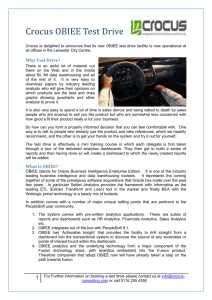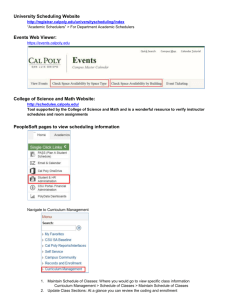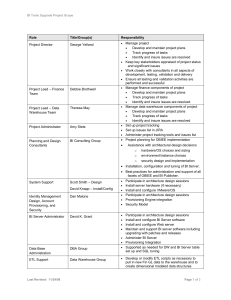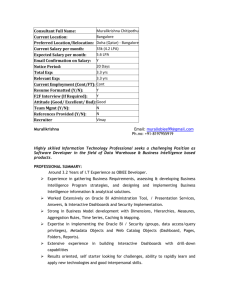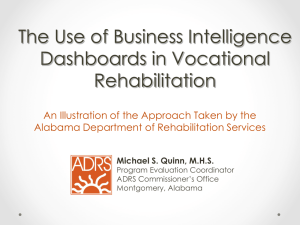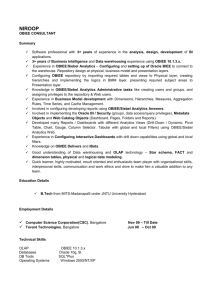Knowledge Data
advertisement
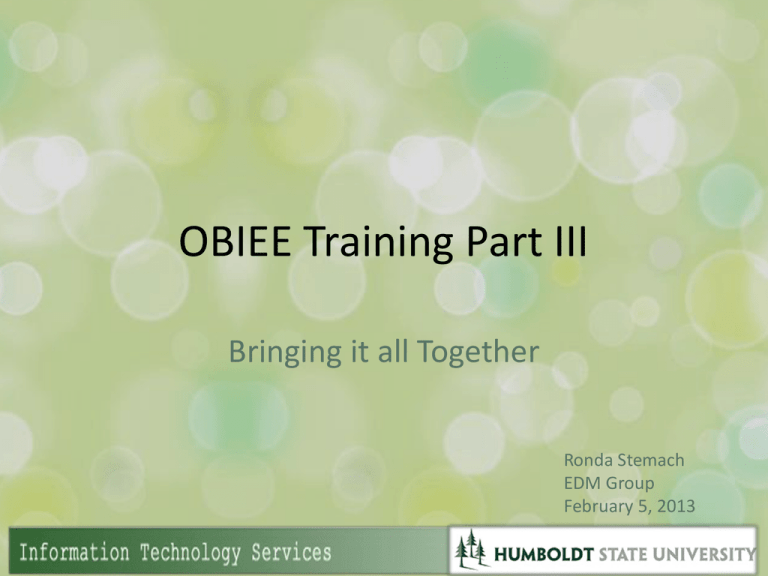
OBIEE Training Part III Bringing it all Together Ronda Stemach EDM Group February 5, 2013 Where we’ve Come • Data Warehouse and Hyperion started in 2008 • Data Warehouse and OBIEE completed in 2010 for Finance and HR Where we’re Going • Introduction of Student Data in Data Warehouse What do we get with EPM 9.1? 1 Number units a Student takendata from our •Fact:ETL - Theofprocess that Ehas xtracts Dimensions: PeopleSoft tables, ransforms Who? Person (and relatedT bio-demo data)data, and Loads dataAcademic into theTerm, Facts and Dimensions of our Data When? Year Warehouse. Where? Class, Department, College hierarchy 2 Translations: •Name Repository – the method used to look at the Fact • and Stu_Car_Term tableTables, = Term Enrollment Dimension apply business logic to them, andoforganize them for&Presentation to the Application Business Rules Logic user. Data Organization & Presentation to OBIEE Author 3 • Catalog – the collection of Delivered Reports, Reports and Dashboards delivered with EPM filters, prompts and dashboards created using Reports OBIEE. and Dashboards created by the Authors 4 Subject Groupings and Areas Data Mart Subject Area Admissions and Recruiting Admission Application Admission Application Status Admission Funnel Application Evaluation External Academic Summary Student Financial Services Award Disbursement Award Snapshot Bill Summary Credit History Payment and Charges Cross Reference Payment Summary Student Financials Accounting Line Student Financials Payment Details Student Financials Transactions Student Financials Transactions Details Subject Groupings and Areas Data Mart Subject Area Student Records Academic Plan Summary Academic Program Detail Class Enrollment Class Instructor Class / Class Meeting Pattern Enrollment Requests Institution Summary Student Degrees Term Enrollment Institutional Research (Snapshots) Enrollment Admissions Completions (Graduation) End of Term Census Data Why OBIEE? Business intelligence (BI) is defined as the ability for an organization to take its Data and convert it into Knowledge • OBI is a Reporting Tool • OBI is the “Front End” view of the Data Warehouse • OBI is about making the mind of your institution’s business talk to you LIVE • Kimball Star Schema Design • Analyze wide range of Information Think about how you Consume Data When you want a weather report, do you go here: Think about how you Consume Data … OR Here: • Summary to Detail • Multiple layers of info • Layout of Information HSU Best Practices in OBI Design Dashboards and Prompts • Prompt Section should appear at the top of the Dashboard • For multi-page dashboards, be aware of the scope of your prompt • The number of pages per dashboard should not exceed the horizontal width of your screen – avoid having to scroll to pages • Don’t overuse the constrain option in prompts – it can really slow down performance • Check “Print Rows” setting of Dashboard, in PDF & Print Properties – All versus Visible • Consider web page eye movement and the level of priority of the elements of your dashboard. HSU Best Practices in OBI Design Analyses • • • • • Always display your filters at the bottom Limit your columns, if possible, to avoid horizontal scrolling Use consistent color coding when possible Use consistent export links Provide insight, not just Excel – create interactive ways to view the data. Create links, drill to-s, different views, pivots… • Provide context – comparison to previous year, comparison to budget, highs and lows, comparison to others. • Make use of the Run Date/Time feature in your Title • Add a Subtitle to further explain the report
